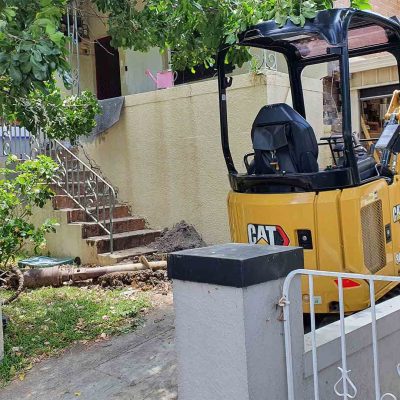Introduction
Landscaping decisions are all about balance—balancing aesthetics, functionality, and practicality. When dealing with sloped terrain, two common options are retaining walls and sloped landscaping. In this blog, we will explore the advantages and considerations of both approaches, helping you determine which is the right choice for your outdoor space.
Retaining Walls: A Structured Approach
Retaining walls are man-made structures designed to hold back soil, creating level terraces on sloped landscapes. Here’s why you might consider retaining walls:
- Erosion Control: Retaining walls are highly effective at preventing soil erosion, ensuring that your outdoor space remains intact even during heavy rains or runoff.
- Versatility: They allow you to create multiple flat levels or terraces on a sloped area, optimizing the use of space for gardens, patios, and seating areas.
- Aesthetic Appeal: Retaining walls come in various materials, shapes, and colors, enabling you to choose a design that complements your landscape and enhances its visual appeal.
- Structural Support: For areas where structural support is crucial, such as beneath a road or building, retaining walls are indispensable for maintaining the structural integrity of your property.
- Low Maintenance: Properly constructed retaining walls require minimal maintenance, offering long-term stability and functionality.
Sloped Landscaping: A Natural Approach
Sloped landscaping, on the other hand, embraces the natural contours of your outdoor space without significant modification. Here’s why sloped landscaping may be the right choice for you:
- Natural Aesthetics: Sloped landscapes offer a more natural and organic appearance, which can be appealing if you prefer a wilderness-inspired look for your outdoor space.
- Lower Costs: Creating sloped landscaping typically requires less construction and materials, potentially reducing the overall cost of your project.
- Eco-Friendly: It’s often a more environmentally friendly approach, as it doesn’t involve extensive excavation or the use of man-made materials.
- Wildlife Habitat: Sloped landscapes can provide a habitat for wildlife, which can be rewarding for nature enthusiasts.
- Rainwater Management: Sloped landscapes are excellent for rainwater management, allowing water to naturally flow, reducing the risk of flooding or water damage.
Choosing the Right Approach
The decision between retaining walls and sloped landscaping largely depends on your preferences, needs, and the specific characteristics of your outdoor space. Consider the following when making your choice:
- Terrain: Assess the slope of your landscape. Steep slopes may require retaining walls for stability, while gentler slopes can be left more natural.
- Functional Needs: Determine how you intend to use your outdoor space. If you need level areas for gardens, patios, or seating, retaining walls may be the better option.
- Aesthetic Preferences: Consider the visual appeal you desire. Retaining walls can provide a more structured and polished appearance, while sloped landscaping offers a natural and rugged look.
- Budget and Maintenance: Assess your budget and willingness to invest in long-term maintenance. Retaining walls may involve higher upfront costs but lower ongoing maintenance, whereas sloped landscaping may be more budget-friendly but require more natural maintenance over time.
Conclusion
Retaining walls and sloped landscaping each offer unique advantages, and the choice ultimately depends on your preferences and the specific requirements of your outdoor space. When making your decision, consider the aesthetics you desire, your budget, the terrain’s slope, and your functional needs. Whether you opt for the structured approach of retaining walls or embrace the natural beauty of sloped landscaping, your outdoor space can be transformed into a harmonious and functional environment.



